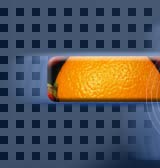



There are four different types of immune reactions in food allergy.
Type 1 (Immediate-Onset) Food Allergy
The best known and well-studied form of food allergies is called a Type 1 immune reaction (aka - a classical food allergy, immediate-onset, IgE-mediated, atopic food allergies, etc.). Type 1 food allergies occur in approximately only 2-5% of the population. Type 1 food allergies occur mostly in children and are less frequent in adults. Usually occurring in the genetically predisposed individual, the immune system begins creating a specific type of antibody called Immunoglobulin E (IgE) to certain foods. One side of the IgE antibody will recognize and bind to the allergic food. The other side of the antibody is attached to a specialized immune cell packed with histamine, called a Mast cell. Primed for action, the IgE antibody now only have to patiently wait for re-exposure to food allergens.
When you eat the allergic food the next time, IgE antibodies hungrily latch onto the food. Instantaneously histamine and other allergy-related chemicals (chemical mediators) are released from the mast cell, quickly bringing on the unwelcome appearance of stomach cramping, diarrhea, skin rashes, hives, swelling, wheezing or the most dreaded of all Type 1 reactions, anaphylaxis.
The Difference Between Immediate & Delayed Food Allergy
1). Once thought to be the only "real" food allergy, immediate food allergy is common in children, but rare in adults. Once thought to be uncommon at best, delayed food allergy is now considered the most common form of food allergy in children and adults.
2). Allergic symptoms in immediate reactions occur within two hours of eating. Allergic symptoms in delayed reactions do not appear anywhere from at least 2 hours to 2 days (there are even reports of delayed symptoms appearing 3 to 7 days after eating).
3). As a rule, immediate-onset food allergy involves one or two foods in the diet. Delayed reactions characteristically involve 3 to 10 foods, sometimes as many of 20 foods in very allergic individuals.
4). Because a small amount of a single food is involved and the allergic symptoms appear immediately, immediate food allergy is usually self-diagnosed. Example: You eat the food, it causes symptoms quickly, you are able to see the connection and you stop eating the food. Due to a combination of delayed symptoms, multiple foods, and food cravings, Type 3 delayed-onset food allergies are extremely hard, if not impossible, to self-diagnose. The only accurate and reliable way to detect the delayed allergic foods is by means of laboratory testing.
5). Immediate food allergy involves foods that are rarely eaten. Delayed food allergy involves commonly eaten foods (i.e. - foods that you eat every day and may even have a craving for).
6). When people quit eating foods that cause immediate symptoms, they have no withdrawal or detoxification symptoms. Powerful addictive cravings and disabling withdrawal symptoms are reported in over 30 percent of delayed food allergy patients when they stop eating food.
7). Immediate food allergens primarily affect the skin, airway and the digestive tract. Virtually any tissue, organ or system of the body can be affected by delayed food allergy. This includes the brain, joints, muscles, hormone-producing glands, lungs, kidneys, and nervous system. Additionally, delayed-onset food allergy is linked to over 100 medical conditions involving every single part of the body and some 100 different allergic symptoms.
8). Immediate-onset food allergies are frequently permanent and fixed allergies. Example: Once you develop an allergy to peanuts or shellfish, it's for life. Delayed-onset food allergies are commonly reversible. If you completely eliminate the allergic foods for 3 to 6 months, you can reintroduce most of them (approx. 86%) back into your diet and remain symptom-free. Because delayed-onset food allergies are so often undetected and untreated, they lie behind many chronic medical conditions of unknown cause. The allergic person suffers for years, even decades, without ever suspecting that their health problems are being caused by what they eat.
9). Immediate-onset food allergy is a skin ("scratch") test positive allergy. Delayed food allergies are skin ("scratch") test negative. The traditional skin tests are poor tests for detecting delayed food allergies. Instead, delayed reactions food require state-of-the-art blood tests. These tests detect serum levels of IgG antibodies to foods.
10). Because delayed food allergies do not make themselves apparent immediately and can be caused by multiple foods, they are very difficult to detect without specialized laboratory testing. There are many forms of allergy testing available such as cytotoxic, computerized cytotoxic, applied kinesiology, vega tests, and others, but each of these tests share the same critical disadvantage - they are frequently unreliable.
The only known laboratory test for accurately identifying delayed-mediated allergic foods is the IgG ELISA Delayed Food Allergy Assay. But be warned...
Some other laboratories provide this type of testing, ONLY Better Control of Health guarantees the following...
1). Research and Validation -
The research supporting IgG ELISA Food Intolerance Testing is substantial. There are MANY studies, including independent double-blind, placebo-controlled trials, supporting the screening of IgG-mediated food allergy.
2). Patient Satisfaction -
* A distinct and clear majority of patients taking the test and altering their diet report that they found significant improvements in their condition.
* Strong improvements were noted in 84% of all cases.
* Often these improvements were noted as being life changing.
* The degree of benefit was found to be particularly strong when patients reported they rigorously altered their diets, though benefit was still noted when diet was only moderately altered.
* An overwhelming majority reported the process to be easy to administer and implement.
* Over 90% said they would recommend OHR's testing to others.
3). Ability To "Reproduce" a Split Sample -
If you were to have your blood drawn, divided into two test tubes ("splitting the sample") and send both tubes of your blood to the same unsuspecting lab under two completely different names, the two lab results should be nearly identical (i.e., in terms of proper identification of reactive foods and the degree of reactivity, the two test results should agree with one another at least 90-93% of the time).
This process is known as "reproducing a split sample" and amazingly enough, most IgG ELISA Food Allergy testing laboratories are unable to do this! Not so with BCH's IgG ELISA Food Intolerance Test! In fact, we challenge anyone to send in split samples!
4). Specimen Stability -
For accuracy and reproducibility, it is important for a delayed food allergy test not to be influenced by the stability of a specimen. Specimens which deteriorate within 24 hours of the blood draw cannot be considered reliable. Not only are the results affected, but the patient is considerably inconvenienced due to the need for a re-draw. Some laboratory's require that specimens are received within 24 hours of the blood draw while others allow between 5-10 days. BCH's testing allows for specimens to be received up to over 4 weeks from the date of specimen collection! (Click HERE for details on our proprietary specimen collection protocol.)
5). Testing of All IgG Sub-Classes -
There are four sub-classes of Immunoglobulin G (IgG). These are IgG-1, IgG-2, IgG-3 and IgG-4. Clinical research has identified that significant allergens are mediated by all four. By not screening for all sub-classes, treatment may be only partially effective. BCH tests for all 4 subclasses with its IgG ELISA Food Intolerance Test.
6). Convenience and Cost -
A reality of life is that we are all busy and have many "things" to do. Additionally, these "things" cost us time and, almost always, money. With the exception of our allergy screening services, all IgG ELISA food allergy testing being provided in the United States by other laboratories require that the person needing and/or wanting to be screened for IgG-mediated food allergy testing must have an ordering physician prescribe the test and that a medical profession, such as a phlebotomist, doctor, nurse, etc., perform a standard, full blood draw. Both of these have their own additional costs... both in time and money. BCH's IgG ELISA Food Intolerance Test DOES NOT require either of these!
Additionally, while other laboratories demand anywhere from over $500.00 to more than $1000.00 for their food intolerance testing, BCH's 96-food assay is available on-line through our safe and secure web store for ONLY $299.00!